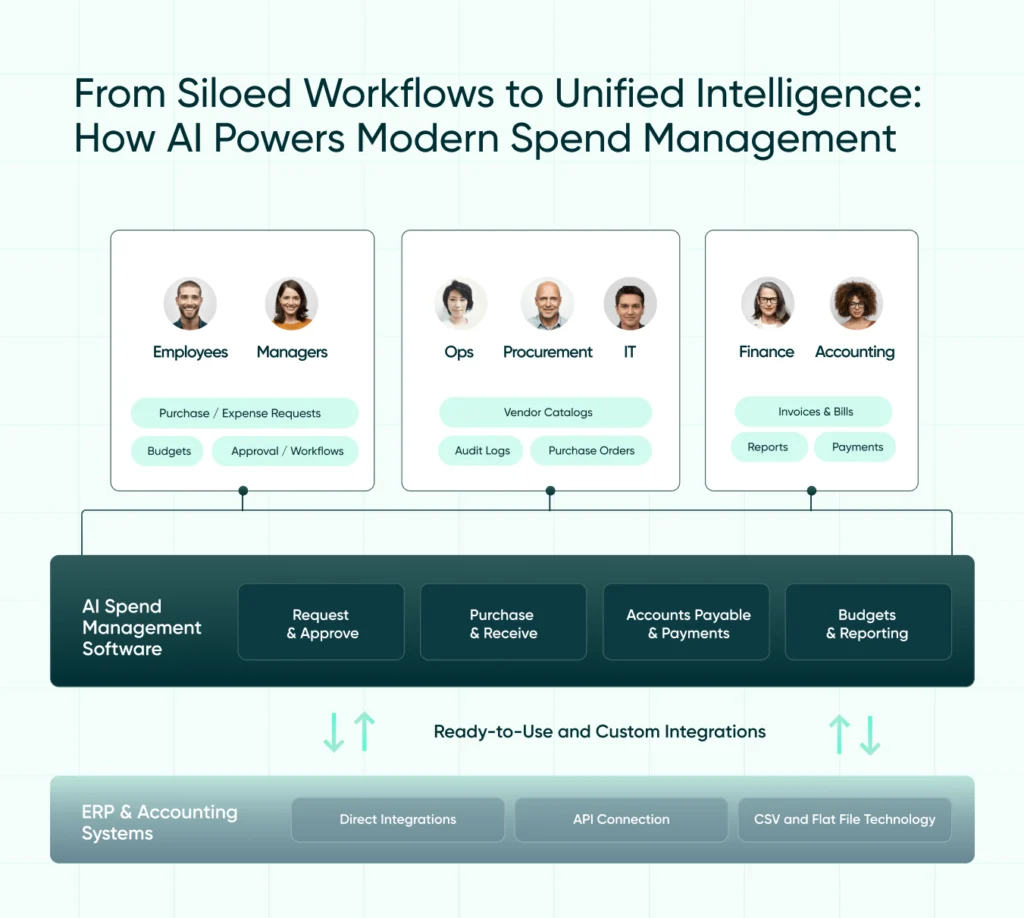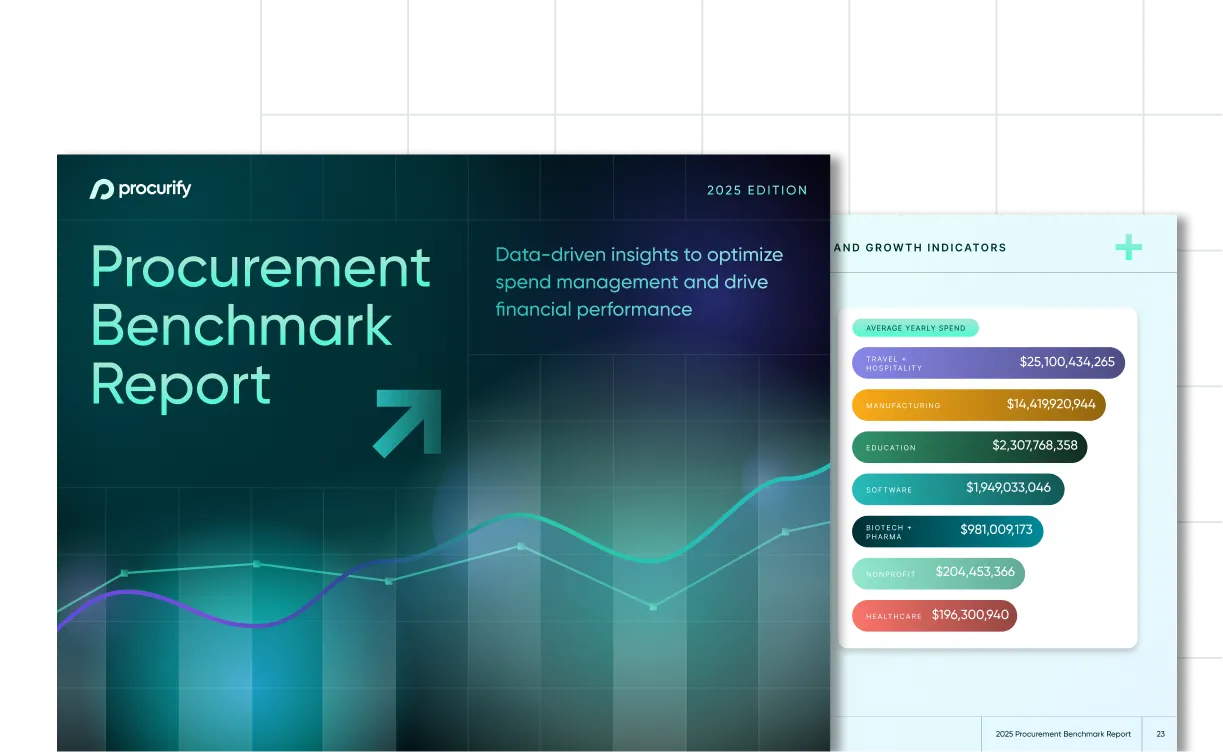
AI in Procurement: What AI-Based Procurement Software Really Does (and Why It’s Worth It)
Procurement teams are under more pressure than ever. They’re expected to cut costs, manage risk, and move faster — all while navigating market volatility, tighter budgets, and growing scrutiny from leadership. And they’re often expected to do it without adding headcount.
That’s where AI in procurement comes in. Modern AI-based procurement software automates manual work, connects siloed systems, and delivers real-time insights across purchasing, approvals, accounts payable, and vendor management. The result? Less time chasing data — more time driving better decisions.
But is it really a game changer, or just another buzzword in the automation boom?
According to Amazon Business, 98% of leaders plan to invest in AI and automation, yet nearly half say system complexity still holds them back.
In this article, we’ll break down what AI-based procurement software actually does, the problems it solves, and whether it truly delivers on its promise for teams that need results — not just hype.
AI-powered procurement analytics: What traditional tools miss
Traditional procurement analytics can only take you so far. Built for teams that already know what they’re looking for, they require pulling the right reports, cleaning the data, and interpreting it manually — a reactive, time-consuming process that often arrives too late to change the outcome.
AI in procurement flips that dynamic. Instead of digging through dashboards or spreadsheets, teams get proactive insights that surface automatically. The system highlights trends, flags risks, and answers specific questions in real time — helping you act before small issues become costly ones.
Take a sudden spike in departmental spend, for example. Without connected data, you’d spend hours chasing context across vendor reports, purchase orders, and spreadsheets. With AI-driven spend insights the system instantly identifies the anomaly — a vendor rate increase or off-contract order — so you can take action right away.
AI-powered procurement analytics catch what traditional tools miss:
- Detect duplicate vendors or split purchases that signal maverick spend
- Flag approval bottlenecks before they slow down fulfillment or cash flow
- Surface off-contract purchases or pricing discrepancies in real time
- Answer natural language queries like “Which department exceeded its budget this month — and why?”
These insights don’t just surface data faster — they help teams prevent overspending, tighten cash flow control, and improve forecasting accuracy. AI turns disconnected procurement data into a continuous feedback system, helping finance and operations teams move from managing spend to mastering it.
Before AI can deliver real value, the foundation has to be right. As John Glasgow, CEO of Campfire, noted in his Op-Ed on the state of modern accounting automation, most mid-market companies are still held back by disconnected systems and manual workflows.
“The first step toward AI readiness,” he explains, “is modernizing and digitizing your core accounting and procurement functions.” Without that connectivity, teams end up importing and exporting data manually — the very inefficiency AI is meant to eliminate.
Once spend, accounts payable (AP), and procurement data live in a unified system, AI can surface meaningful insights and automate work confidently — not as a black box, but as a transparent, auditable tool that strengthens financial decision-making
Why spend visibility is still hard and how AI makes it easier
Even with centralized systems, visibility remains elusive. Access to data isn’t the same as understanding it. True visibility means knowing what’s happening, why it’s happening, and what to do next — without chasing reports or toggling between disconnected tools.
In most organizations, procurement, finance, AP, and ERP systems each hold only part of the picture. Understanding what’s been spent, what’s pending approval, and what’s coming next can take hours.
AI-based procurement software bridges those gaps. It consolidates data across systems into a single, real-time view, filters out noise, and surfaces what matters most. This clarity helps finance leaders catch cost overruns earlier, improve forecasting accuracy, and reduce time spent reconciling reports.
Real-time alerts identify risks such as:
- Requisitions stalled beyond SLA thresholds
- Vendors billing above contract rates
- Departments drifting over budget
- Products with rising per-unit costs
When everyone — from procurement to finance to operations — works from the same live data, collaboration improves. Teams act faster, stay aligned, and make informed decisions with full context, not just more data.

What to look for in procurement software
When evaluating AI-powered procurement tools, look for platforms that combine intelligence with automation — helping your team uncover insights and streamline work at the same time. Modern platforms now include mobile-first purchasing, smart contract-to-vendor matching, and touchless invoice processing — features that were once optional but are now essential for speed and accuracy.
Here are the capabilities that separate the best procurement software from the rest:
Key capabilities to look for:
- Natural language query tools that let users ask questions and get data-backed answers
- The ability to surface anomalies easily and quickly without needing dashboard digging
- Embedded analytics and up-to-date smart dashboards
- Workflow tracking for approvals, contract terms, and compliance checkpoints
- Easy integration capabilities with your ERP and accounting systems
- Role-based access controls and audit trails for secure, compliant operations
- AI-driven invoice processing and automated data extraction
- Automated three-way matching to reconcile POs, invoices, and receipts
- Support for deposit billing and flexible account code allocation
- Smart upload and classification of contracts and supporting documentation
How AI simplifies accounts payable (and saves hours each week)
Manual invoice processing drains time, introduces risk, and delays visibility into company spend. AI changes that by automating every step of the accounts payable (AP) workflow — from invoice capture to payment reconciliation.
When an invoice arrives, AI-powered optical character recognition (OCR) automatically scans and extracts key details from headers and line items, creating a draft bill in seconds. Instead of typing and checking fields manually, AP teams review and confirm — cutting data entry time to near zero.
Invoices can be forwarded to a secure inbox by any team member. The system interprets the data, flags discrepancies, and routes invoices for approval automatically. This ensures that AP specialists focus on validation and exception handling, not repetitive processing.
Three-way matching is also fully automated. The system links invoices to purchase orders (POs) and receipts, identifies quantity or cost variances early, and prevents duplicate or out-of-policy payments before approvals are issued.
Deposit billing and prepaid tracking are built in. AP teams can manage deposits in real time and reclassify them automatically once goods are received, improving cash flow visibility and keeping accounts aligned with standard practices.
Together, these capabilities transform AP from a reactive, manual task into a connected, intelligent workflow — reducing errors, minimizing delays, and giving finance teams confidence that every payment is accurate and complian
Security and compliance in AI procurement tools
Security isn’t a feature — it’s a foundation. Modern AI procurement tools are built with security and compliance woven into every workflow, not added on afterward.
The best platforms include role-based access controls, comprehensive audit trails, and data encryption to safeguard sensitive financial information. Support for SOC 2 and GDPR compliance ensures that every transaction, approval, and payment aligns with strict governance standards.
By embedding compliance directly into purchasing and AP workflows, AI systems give finance and IT teams the confidence that every action is secure, traceable, and compliant — without slowing down operations.
How easy is it to implement AI procurement software?
Adopting AI procurement software doesn’t have to mean overhauling your tech stack. Modern platforms are designed for fast, low-lift implementation, so teams can start realizing value in weeks — sometimes even days.
Take Questrade Financial Group, for example. Facing a tight migration window, their finance team fully implemented Procurify’s AI-powered procure-to-pay platform in just one week. Within days, they gained full visibility into purchase orders and approvals — eliminating email-based workflows and improving accountability across every department.
Intuitive onboarding, guided setup, and prebuilt integrations make adoption straightforward, even for large, fast-moving organizations. Instead of replacing your ERP or accounting system, these platforms layer on top, filling the gaps between purchasing and payments. The result: faster approvals, automated routing, and fewer bottlenecks at month-end.
With ERP, AP, and expense integrations built in from day one, teams quickly gain real-time visibility and control — proof that intelligent spend management can be both powerful and practical.
Who should use AI procurement tools?
AI-powered spend analysis tools are ideal for mid-sized and growing organizations with limited resources looking to control spend. If your team spends more time chasing invoices or reconciling reports than managing spend strategically, it’s time to modernize.
These platforms give finance and procurement teams the visibility, automation, and control needed to make faster, data-driven decisions — without waiting for end-of-month reports. By surfacing insights in real time and streamlining repetitive tasks, AI helps organizations prevent overspending before it happens.
Who benefits most:
- Finance leaders gain instant visibility into budgets, burn rates, and cash flow, enabling faster, more confident forecasting.
- Procurement managers can monitor vendor performance, flag risks, and enforce policy compliance from a single dashboard.
- AP teams cut hours of manual entry with automated invoice matching and faster approvals — reducing close times and errors.
- Operations leaders get a live view of departmental spend, helping them plan resources and projects with greater precision.
AI procurement software turns visibility into agility — helping every team move faster, spend smarter, and stay aligned.
What you gain with AI-powered procurement analytics
When analytics are real-time, reliable, and embedded in daily workflows, procurement transforms from a back-office function into a strategic advantage. AI-powered insights don’t just show what’s been spent — they reveal where teams can act faster, save smarter, and plan with confidence.
Here’s what that unlocks:
- Cost control: Detect pricing anomalies, duplicate vendors, and out-of-policy spend before they become financial leaks.
- Smarter forecasting: Use live data to improve budget accuracy, cash flow predictability, and scenario planning.
- Faster decisions: Eliminate delays with insights surfaced automatically inside the tools your teams already use.
- Stronger supplier strategy: Benchmark performance, identify negotiation opportunities, and mitigate vendor risk proactively.
- Cross-team alignment: Give finance, procurement, and operations a unified view of spend — no more back-and-forth over static reports.
When AI-powered analytics turn spend data into action, procurement doesn’t just track performance — it drives it.
AI in procurement: hype or a worthwhile investment?
AI in procurement isn’t just living up to the hype — it’s quietly becoming the new standard. Teams that once spent hours chasing approvals or reconciling invoices are now closing books faster, enforcing policy with ease, and making data-driven decisions in real time.
AI-powered procurement tools don’t replace people — they empower them. By taking care of the tedious work like data entry, matching, and report generation, they give finance and procurement teams back the time to focus on what matters: strategy, savings, and smarter growth.
The results are already clear. Consider organizations like Sahara Kuwait who reduced approval times by up to 93%, saving tens of thousands of dollars within weeks, or Mitra Chem who saw a 10x increase in purchasing efficiency. These aren’t just operational wins — they’re proof that spend management drives stronger business performance.
AI in procurement isn’t a someday technology. The bigger risk isn’t trying AI—it’s sticking with systems that weren’t built to keep up. Delays, missed savings, and bad forecasts carry a cost. AI helps reduce that cost with clearer data, fewer errors, and decisions made with confidence. At Pulse 2025’s event, the AI Edge in Procurement sessions, finance and procurement leaders shared how they’re already putting these ideas into action.

2025 Procurement Benchmark Report
Powered by $20B+ in proprietary data you won’t find anywhere else.

